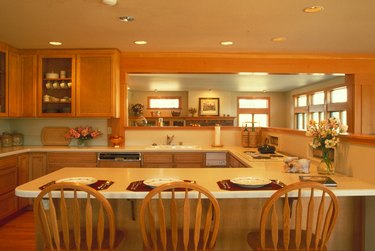Things You'll Need
Measuring tape
Marking pencil
Wooden cleats
Drill with wood and masonry drill bits
Plastic lags
Wood or drywall screws
Construction adhesive
Small finish nails

A kitchen island can provide an ideal extra work area in the center of your kitchen. An island can be added to any type of flooring, but to secure it to a tile floor, cleats should be attached properly to the tile to prevent any damage to the floor and to prevent movement of the island.
Step 1
Measure the inside of the perimeter of the island cabinet or island base. Mark your measurements on the tile floor.
Video of the Day
Step 2
Set wooden strips, also known as cleats, on the inside of your measurements on the floor. Pre-drill holes, using a wood drill bit, through the cleats where the screws will go (place a screw at least every 8 to 10 inches). Place the wooden cleats on the tile and mark where the holes hit the tile. Use a masonry bit to pre-drill holes in the tile where marked. Place a plastic lag in the holes in the tile. Align the cleats over the holes and secure with wood or drywall screws.
Step 3
Apply a strip of construction adhesive to the outside edge of the cleats and set the cabinet or island base over the wooden cleats.
Step 4
Attach your toe kick (if using one) at the bottom of the cabinet along the flooring with a small strip of adhesive and small finish nails every 6 to 8 inches.
Tip
Before you secure the island to the floor, draw a chalk line on the floor of the island placement to get a feel for spacing and determine if you need to move or change edges and angles.
Proper spacing for an island is 36 to 42 inches between cabinets and the island if it is near a plain wall, and at least 36 inches if near an appliance; 42 inches is best.
If space is limited, try another option instead of an island, like a portable utility cart or a single cabinet and add a butcher block or ready-made countertop to it. The portable cart would not have to be secured to the floor, and you would have the convenience of moving it easily if desired. The cart could be placed on a rug with nonslip grippers on the back side to prevent slippage and damage to the floor.
If your island is small, it should be secured to the floor to prevent slippage or tipping over. A very large island, accounting for the weight of the cabinet and items in the cabinet and drawers, might weigh as much as 1,000 pounds or more, and not necessarily need to be secured to the floor.
Video of the Day